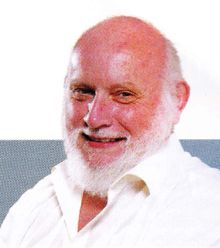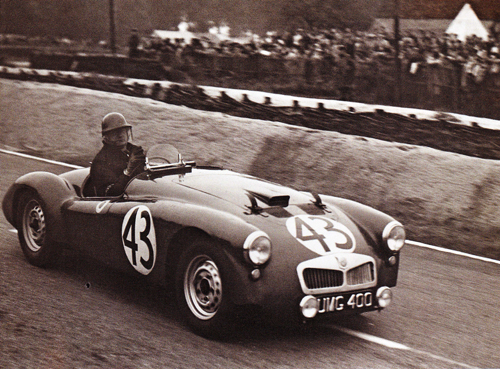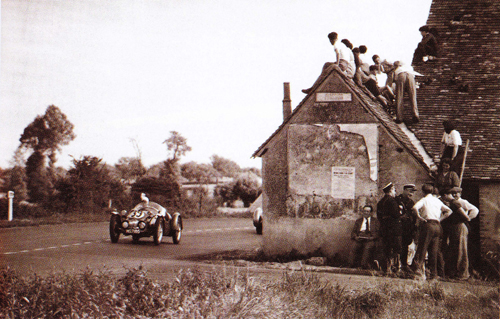Origin of a Species

 Sitting in the sun on a fence rail, amongst the car concours line-up at our local Bourne Show near Farnham, I couldn’t help but admire a lovely signal-red MGA which came purring in to park. Ever since MGAs were new in the 1950s I have always admired them, and back in the late 1970s I spent a memorable few days exploring the background to the model with its originators, the legendary Syd Enever and his body-specialist colleague Eric Carter of MG at Abingdon.
Sitting in the sun on a fence rail, amongst the car concours line-up at our local Bourne Show near Farnham, I couldn’t help but admire a lovely signal-red MGA which came purring in to park. Ever since MGAs were new in the 1950s I have always admired them, and back in the late 1970s I spent a memorable few days exploring the background to the model with its originators, the legendary Syd Enever and his body-specialist colleague Eric Carter of MG at Abingdon.
During WWII, Syd was in charge of Crusader tank development in MG’s famous Abingdon works and while the ground-floor workshop churned out Crusaders, Centaurs and modified Shermans, the first floor was devoted to fuselage sections for the ArmstrongWhitworth Albemarle bomber aeroplane. Enever helped detail the section for production, working closely with Armstrong-Whitworth’s design team.
After the war he returned to cars, as MG’s engineer on site liaising with the remote Nuffield Group management at Cowley. He was an alert, far-sighted and inquisitive engineer who, with the probable exception of Jaguar’s Malcolm Sayer, had the best grasp of aerodynamic body design anywhere in the British motor industry.
At that time MG TCs were being raced and rallied worldwide. One most enthusiastic British driver was George Phillips, a rugged bulldog character, a newspaper dispatch rider turned photographer. ‘Phil’ became Autosport magazine’s photographer and grumbled his way around the International motor racing circuit for many a long year.
In 1949, Phil, Dick Jacobs and Ted Lund were three privateers provided with works-prepared TCs for some English races. In 1950 the TCs were replaced by TDs. Phil really wanted to race at Le Mans and he won a private entry in the first post-war 24-hour race there, in 1949. He designed and built his own special body for his TC, co-drove it there with ‘Curly’ Dryden but was disqualified after 19 hours. In 1950, co-driving with Eric Winterbottom, he was then placed 18th overall and second in the 1½ litre class to a Jowett Jupiter. MG’s finest were impressed and offered him a special works-prepared car for the 1951 race.

Syd Enever was briefed to produce it, and work began on project EX172 in the MG Experimental Register – to become better known as ‘UMG 400’ or ‘The Phillips Le Mans TD’.
As Phil told me in 1979: “They’d only got the TD and couldn’t build us a proper specialised car. So I said ‘Well, let’s lighten the TD chassis and put a lighter body on it” – I thought it would be nice to build something looking a bit like the Sunbeam-Talbot of that time. I think the project started pretty surreptitiously. Alec Hounslow was in charge. When Smith, the boss man from Cowley, visited Abingdon they’d wheel the car out onto the field so he wouldn’t see it.
“Eventually it came to the showdown day and they didn’t know if they’d have a job or not if Smith didn’t like it! Anyway, it seems he did because they ran the car for me and they all stayed on.
“At Le Mans the car was quicker down the straight than my own, but it had worse oversteer and I could have got my own car through the corners more quickly. Anyway, it was quicker round the lap and I was really chuffed when it lapped in six minutes. But I didn’t like sitting on the thing rather than in it. I said ‘Why don’t you use a backbone chassis like the old R-Type’ – MGs pre-war single-seater -‘and sit the bloke on the floor?’- but of course it was all too late by then.”

Neither did grumpy Phil admire Abingdon’s engine tune: “The previous year poor old Eric Winterbottom…” – he would be killed driving a Frazer Nash in the 1951 TI at Dundrod – “…had asked me what the rev limit was on my car and I told him straight: ‘When you get vapour coming out of the carburettors change gear!’ I reckoned that if the engine I’d built on my kitchen table would run 24 hours like that then a works-prepared engine ought to be absolutely unburstable – but it wasn’t.
“I told ’em I didn’t want their fancy valves, just straight KE965 made-up valves because they were indestructible. Anyway, I was chasing Hay’s Bentley down the straight early in the race when I blew the head off a piston and bent the valves. Alan Rippon drove it with bent valves and a holed piston and the sump kept filling with petrol. If we could have kept the petrol out of the sump we might have kept going, but it was no good. I was bloody furious with MG, and they were upset with me. When they later asked if I’d like the car I said ‘No’, and by the time Rippon made his mind up they’d put it under the hammer.”
Syd Enever had built ‘UMG 400’ with experience from his streamlined record car EX135 for Goldie Gardner, modifying the record car’s bodyshell design to make it practical for racing and road use. The result was mounted on a TD chassis, which dictated the high seating position that Phil so disliked, with the driver perched on top of the chassis rail, instead of down beside it.
Syd was a regular visitor to his wartime friends at Armstrong-Whitworth, using their wind tunnel at Whitley, near Coventry. He would sketch body shapes, which were converted into quarter-scale wooden models by Harry Heering in MG’s body shop. Mr Beech – A-W’s aerodynamicist – gave his services free of charge to MG and wind-tunnel results proved instrumental in the development of ‘UMG 400’ and from it – and here at last comes my point – the MGA.
Merely to protect EX172’s driver adequately, a windscreen some 20-inches deep would be needed, so one evening at home in Westminster Way, Oxford, Syd Enever sketched a new chassis frame (to become EX175) in which the side members swept outside the cockpit area, allowing a lowered seat to be dropped between them to seat the occupants at an acceptable level.
He drew a new body shape with raised cockpit sides to avoid the broken-backed profile of EX172 and Harry Heering again modeled the result for the wind tunnel. Within three months Eric Carter and his colleagues at Bodies Branch in Quinton Road, Coventry, had finished a prototype, and this new chassis-body structure was a first for MG, so long wedded to timber-frame body construction. And from that car the MGA emerged as the long-overdue production replacement for the TF. And as Syd Enever told me, looking back “We had a nice car in the MGA. It was always good to us…”.
NAMGAR wishes to thank Motorsport magazine for their permission to reproduce this article from the October 2015 issue.

